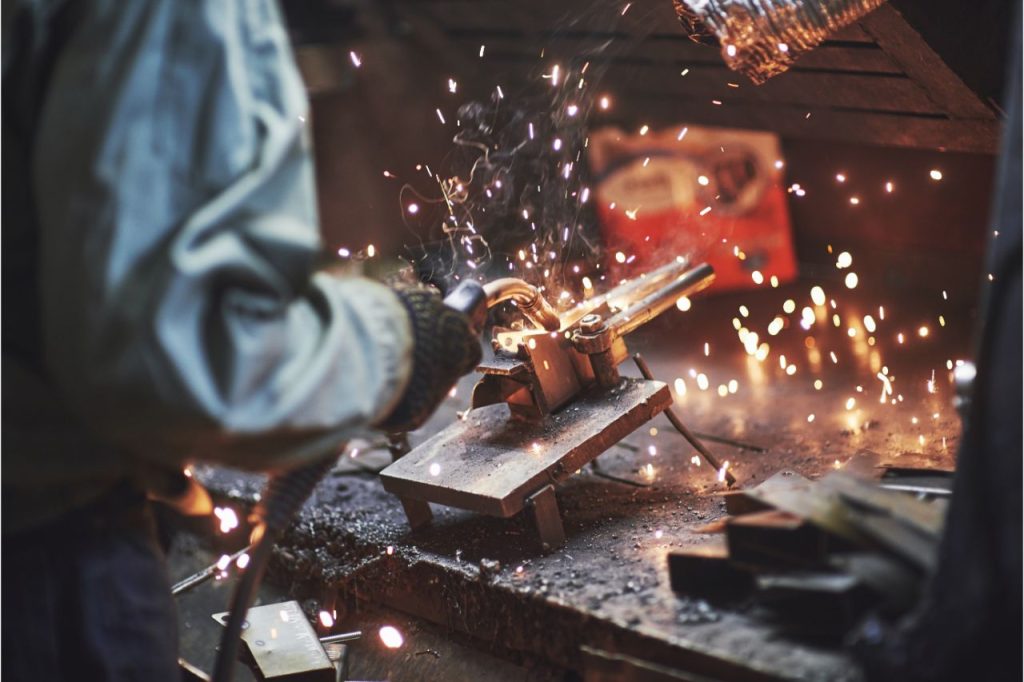What welding techniques are used for pipes?
- Shielded Metal Arc Welding (SMAW)
- Gas Metal Arc Welding (GMAW)
- Flux-Cored Arc Welding (FCAW)
- Submerged Arc Welding
- Tungsten Inert Gas (TIG) Welding
Pipe welding has its place in many industries — construction, oil and gas, water, fabrication, power generation, among many others. It’s an incredibly important and specialized method of fabrication.
There are several welding techniques that fabricators must understand to get their products made in the best and safest way possible. Factors such as application, material, temperature, availability of filler material, and more play into which technique best applies. To give you a better understanding of this topic, here are the five welding techniques for pipes, and how they differ from each other.
Why do we weld pipes?
Welding is an effective joining method — it provides many benefits for manufacturers. Welding eliminates the need for fittings between sections of pipe, which can make fabrication more labor and cost-efficient.
Welded pipes gain improved flow, as fittings result in more fluid resistance in the flow through the pipe. This streamlined section is also less prone to leaks or cracks. Welded pipes are also generally very easy and quick to repair, as it requires no disassembly or reassembly.
Here are the five techniques used to gain these pipe advantages:
Shielded Metal Arc Welding (SMAW)
SMAW welding goes by many names, like Manual Metal Arc Welding (MMA or MMAW), Flux Shielded Arc Welding, and even stovepipe and stick welding.
In this technique, the electrode is melted through the heat generated by an electric arc. This molten material is manually applied to sections of metal pipe to join them together. The main advantage of using SMAW welding is that it requires no flux nor shielding gas — it’s simple, portable, and requires minimal equipment.
However, the SMAW technique is less productive than others due to its lower travel piece. And, welders must ensure their welding machines are fitted with the suitable electrode for the material.
To produce a good quality weld, welders must also take into account arc stability, depth of penetration, metal deposition rate, and positional capability. These factors are greatly influenced by the chemical composition of the flux coating on the electrode.
Gas Metal Arc Welding (GMAW)
Gas Metal Arc Welding (GMAW) techniques include Metal Inert Gas (MIG) Welding and Metal Active Gas (MAG) Welding methods. These apply a shielding gas along the electrode, which heats the two metal pipe sections to be joined.
This method has greater speed, versatility, and productivity than SMAW, as it is performed with semi or fully automatic tools. It also offers high deposition rates, no risk of slag entrapment, and low fume generation.
However, this technique requires more control from the welder to produce high-quality welds. Its tools also require constant voltage and a direct power source. It cannot be done outdoors without enclosures, as the welding gas may be dispersed by wind.
Flux-Cored Arc Welding (FCAW)
This technique has two subcategories: self-shielded and gas-shielded FCAW. The gas-shielded method uses semi-automated tools to provide high speed and productivity, but wind can disturb the shielding gas and result in porosity defects. The self-shielded method avoids this by not using a shielding gas but is less productive overall.
The advantage of using FCAW welding is that it is preferable for outdoor welding as well as thicker materials. And, it is more portable and convenient than the GMAW technique. FCAW offers higher deposition rates and better arc stability than GMAW. It also requires less preparation and cleaning of the metal pipes than other techniques.
The disadvantage of using this technique is that it produces hazardous gasses, which can lower weld visibility during operation. It also generates more smoke than other techniques. Porosity can become an issue if this gas is not able to disperse before the weld solidifies. Another disadvantage is the amount of slag it produces — which needs to be removed per weld layer. It is not recommended for welding on thinner pipe materials.
Submerged Arc Welding
This is a semi-automatic technique that has a non-visible welding arc. In this process, an electric arc is formed between a continuously fed electrode and the metal pipe. A layer of powdered flux is produced, which covers the arc. When this flux melts, it provides conduction between the metal and electrode, which protects the weld zone.
Thus the electric arc is “submerged” beneath a blanket of flux. This makes it a more demanding technique to perform, as tracing is difficult. However, it offers sound, defect-free welding, along with the highest deposition rates out of all the pipe welding techniques available.
This technique is ideal for those with experienced welders, as well as applications requiring longitudinal and circumferential butt welds. This is most common for manufacturing line pipe and pressure vessel materials.
Tungsten Inert Gas (TIG) Welding
Tungsten Inert Gas (TIG) Welding, also known as Gas Tungsten Arc Welding (GTAW), is the most common method for stainless and non-ferrous metal welding. It uses a fixed consumable electrode to create its weld. This process is more time-consuming than even SMAW.
TIG welding is very versatile, being suitable for various metals and applications. It also produces high-quality welds, making it ideal for critical and high-precision welding jobs.
However, this quality is largely dependent on welder skill, as it is fully manual. And, it has much lower deposition rates and higher equipment and labor costs than other techniques.
Key Takeaway
Welding techniques for pipes require specific knowledge, skill, and equipment — making it a very specialized field in the pipe fabrication industry. Understanding the basics behind each technique is crucial for those interested in fabricating metal pipes for their application.
Need expert welding know-how and services? Send a message to Supreme Pipe today. We know the best welding process for your application based on your needs and priorities. We guarantee that we deliver the best-made metal pipes for your project.
